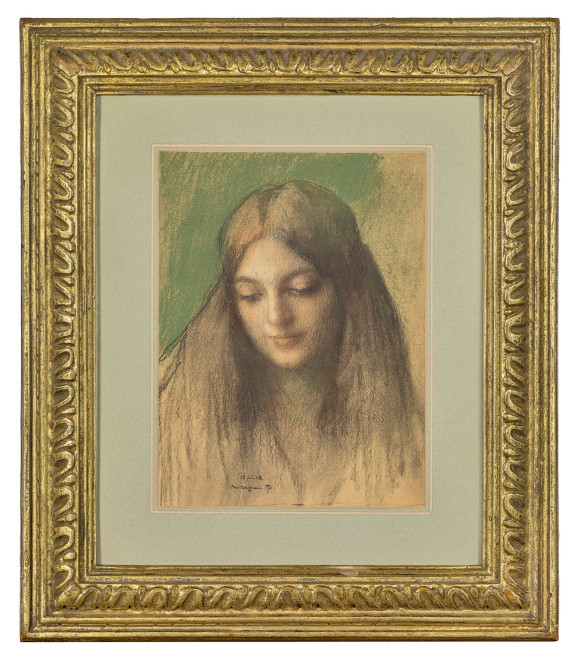The painting, Consolatrix Afflictorum, “is now on the canvas, and I cannot explain my admiration. Really Dagnan is the greatest Master living and feel certain you will agree when you see the picture next year” (Letter from Edmond Simon from Arthur Tooth & Sons to Henry Clay Frick, 8 July 1898).
Provenance
Private Collection, New York
Thence by descent
Catalogue note
Our pastel is a study for the central figure of the Madonna in Consolatrix Afflictorum (The Consoling Madonna), Dagnan-Bouveret’s monumental religious composition from 1899. In Consolatrix Afflictorum, the Madonna, flanked by angels playing music in a mystical forest, isseated on a throne with the infant Jesus on her lap. Both the composition and subject matter reveal Dagnan-Bouveret’s talent and erudition and are reminiscent of Leonardo da Vinci’s Virgin of the Rocks (National Gallery, London and The Louvre, Paris). Several compositional studies of Consolatrix Afflictorum exist, but only two studies of the Madonna are known: one is an oil at the musée Georges Garret in Vesoul, France, the second is our pastel.
The study for the Madonna offers insight into Dagnan-Bouveret’s creative process and his resolutely modern eye. His attention to the effects of light and color, such as the use of delicate shades of green for the background and to frame the model’s face, is especially striking. In the early 1890s, while at the height of his career, Dagnan-Bouveret shifted his attention from naturalistic scenes toward the creation of mystical and symbolist compositions based on color harmonies and mood responses. This pastel, as the genesis of the religious composition Consolatrix Afflictorum, embodies these new artistic explorations and serves todemonstrate the healing powers of Madonna and Christ and the hope for salvation.
This message may have appealed to the sensibility of American millionaire Henry Clay Frick from Pittsburgh, who purchased Consolatrix Afflictorum in 1898 before any painting had begun. It took two-and-a-half years for Dagnan-Bouveret to complete the project. The long-awaited painting was praised by Frick, who hung it in his mansion dining room until his move to New York city. It is now part of the collection of the Frick Art and Historical center in Pittsburgh.




